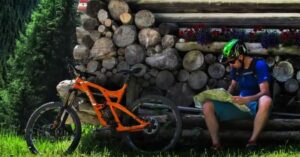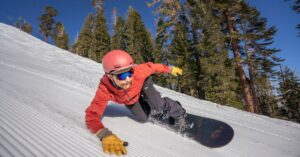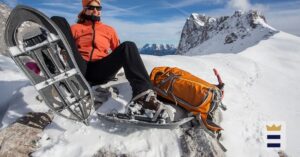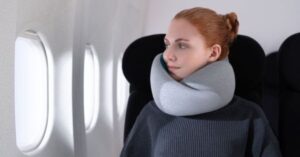- Versatile for road and indoor
- Compatible with SPD, SPD-SL cleats
- Fiberglass sole boosts power transfer
- Durable synthetic leather and mesh
- Lightweight design for all-day comfort
- Cushioned heel absorbs every step
- Flexible build supports active movement
- Removable insoles for custom fit
- Includes cleats and installation wrench
- Breathable mesh upper keeps feet cool
- Durable nylon sole ensures safe rides
- Compatible with Peloton and road bikes
- Comes with pre-installed delta cleats
- Compatible with Peloton and SPD systems
- Durable high-quality nylon sole design
- Ideal for indoor and outdoor cycling
- Neoprene design keeps feet warm
- Reflective details enhance night safety
- Lockable zipper prevents water entry
- Durable Kevlar base resists wear
Best Bike Shoes
Finding the best bike shoes can make every ride smoother, safer, and more powerful. Whether you cycle indoors or outdoors, the right pair offers comfort, grip, and efficient energy transfer. From performance-driven road shoes to flexible commuter options, the best bike shoes enhance your control, speed, and overall riding experience.
1. SHIMANO
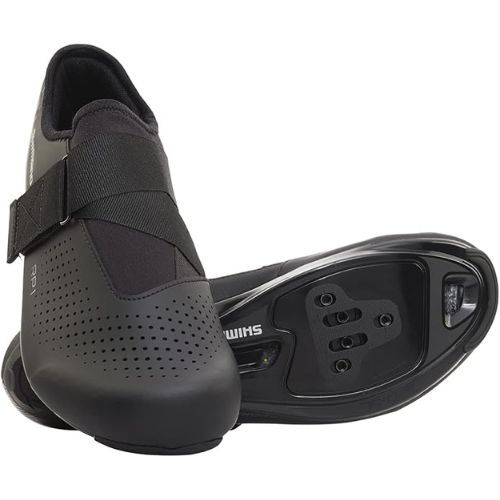
SHIMANO cycling shoes are built for both indoor and outdoor riders seeking performance and comfort. With a reinforced sole for better power transfer, breathable mesh panels, and secure fit straps, they deliver stability and efficiency on every ride. Their durable design ensures long-lasting performance for professional and casual cyclists alike.
Experience the perfect blend of performance and versatility with SHIMANO SH-RP101 cycling shoes – designed for cyclists who demand quality, comfort, and power transfer in every ride.
Key Features & Benefits
- Versatile Design – Perfect for both road cycling and indoor trainer sessions, making these shoes ideal for year-round training
- Universal Cleat Compatibility – Features an adaptable 5-hole outsole that works with both SPD and SPD-SL cleats and clip-in pedals
- Maximum Power Transfer – Fiberglass-reinforced sole delivers efficient energy transfer from your legs directly to the pedals for better performance
- Built to Last – Constructed with high-quality synthetic leather and breathable mesh materials for long-lasting durability
- Easy Secure Fit – Simple slip-on design with single strap closure system ensures a snug, comfortable fit every time
- All-Rounder Performance – High-performing design suitable for recreational riders, fitness enthusiasts, and serious cyclists
Available Options
This cycling shoe comes in multiple sizes to fit different foot dimensions. Check the size chart to find your perfect match for optimal comfort and performance.
How to Use
- Cleat Installation: Attach your preferred SPD or SPD-SL cleats to the 5-hole outsole system
- Fitting: Slip your foot into the shoe and adjust the single strap for a secure fit
- Pedal Engagement: Step onto your compatible clip-in pedals and twist to engage
- Post-Ride Care: Clean with damp cloth and allow to air dry for best maintenance
Perfect For
- Road cycling enthusiasts
- Indoor cycling and spin class participants
- Cyclists seeking versatile footwear options
- Riders wanting reliable power transfer
- Anyone looking for durable, comfortable cycling shoes
Ready to improve your cycling experience? Add the SHIMANO SH-RP101 to your cart today and feel the difference that quality cycling shoes make in your performance and comfort. Your feet and your rides will thank you.
2. Rockport
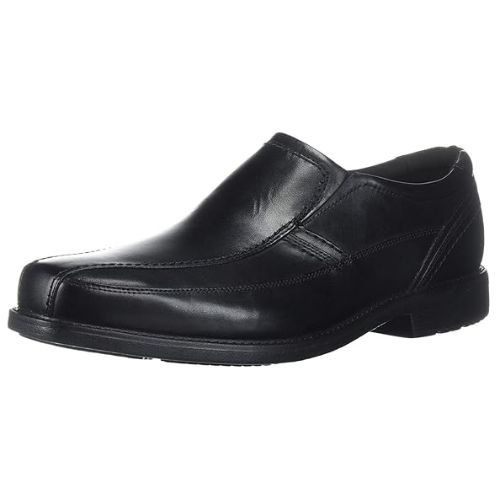
Rockport cycling-inspired slip-ons combine style, comfort, and function. Lightweight yet supportive, they feature cushioned insoles and breathable materials for all-day wear. Designed for flexibility and active movement, Rockport shoes offer superior comfort whether commuting, walking, or riding, ensuring a balance between modern design and everyday practicality.
Step into comfort that lasts all day with Rockport's Style Leader 2 Bike Slip-On shoes, designed for men who value both style and performance in their everyday footwear.
Key Features & Benefits
- LIGHTWEIGHT DESIGN – Advanced lightweight technology reduces foot fatigue during extended wear, making these shoes perfect for long days at work or casual outings
- SUPERIOR CUSHIONING – Built-in comfort technology absorbs impact with every step while providing long-lasting heel cushioning for maximum support
- ENHANCED FLEXIBILITY – Engineered for active lifestyles with optimized flexibility that moves with your foot, delivering comfort and support in every step
- CUSTOMIZABLE FIT – Memory foam removable insoles allow you to personalize your comfort level or easily accommodate your own orthotic inserts
- BREATHABLE MATERIALS – Advanced breathable construction keeps your feet cool and dry throughout the day, preventing moisture buildup
- SLIP-ON CONVENIENCE – Easy slip-on design saves time while providing a secure, comfortable fit without the hassle of laces
Available Options
- Extended Size Range: Available in multiple sizes to ensure the perfect fit
- Various Widths: Choose from different width options for optimal comfort
- Multiple Color Options: Select from available color variations to match your style preferences
Perfect For
- Daily office wear and business casual settings
- Extended walking or standing periods
- Men seeking comfortable slip-on footwear
- Those requiring orthotic-friendly shoe options
- Active individuals who need flexible, supportive shoes
Care Instructions
- Clean with a damp cloth and mild soap when needed
- Allow shoes to air dry completely before wearing
- Remove insoles periodically to maintain freshness
- Store in a cool, dry place when not in use
These Rockport Style Leader 2 Bike Slip-On shoes combine practical comfort with versatile style, making them an excellent choice for men who refuse to compromise on either comfort or appearance. The lightweight construction and cushioned support make them ideal for all-day wear, whether you're at the office or enjoying weekend activities.
Ready to experience superior comfort and style? Add these Rockport slip-on shoes to your cart today and discover why thousands of men trust Rockport for their everyday footwear needs.
3. KESCOO
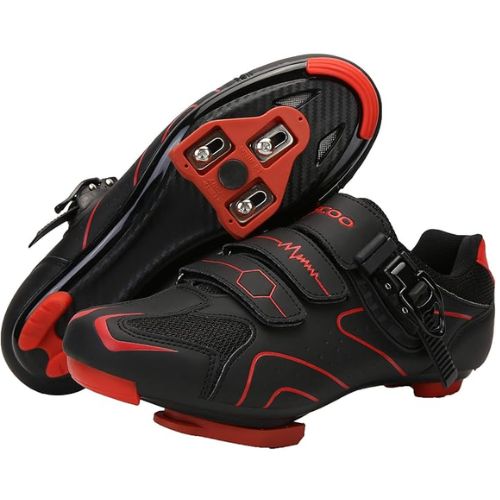
KESCOO cycling shoes are crafted for indoor and road enthusiasts, offering versatility and precision. Featuring breathable synthetic uppers, durable nylon soles, and included Delta cleats, they provide a secure fit and optimal energy transfer. Perfect for Peloton or outdoor rides, KESCOO shoes deliver performance and comfort for every cyclist.
Experience comfort and performance with every ride. The KESCOO cycling shoes are designed for serious cyclists who demand quality, compatibility, and comfort in their indoor and outdoor cycling adventures.
Key Features & Benefits
- Complete Package Ready – Includes delta cleats and installation wrench so you can start riding immediately without additional purchases
- Superior Breathability – Lightweight synthetic upper with mesh inserts keeps your feet cool and comfortable during long rides
- Universal Compatibility – Multi-functional nylon sole works with SPD-SL and delta cleats, making these shoes perfect for Peloton bikes and most road bikes
- Durable Carbon Fiber Design – Sturdy sole with attractive carbon fiber pattern provides excellent power transfer and long-lasting performance
- Versatile Use – Ideal for spin classes, road cycling, touring, and indoor bike training sessions
- Safety First – Hard outsole design ensures secure cleat attachment and stable pedaling for safer rides
Product Variations
Available in multiple unisex sizes to fit both men and women. The shoes feature a sleek design suitable for any cycling environment, from home workouts to outdoor adventures.
Sizing & Usage Guidelines
Important Sizing Note: These shoes run small. Please order half a size larger than your normal shoe size. For example, if you typically wear a women's size 6, order a women's size 6.5. Refer to the detailed sizing chart in the product images for the most accurate fit.
Compatibility Notice: While these shoes come with delta cleats for Peloton bikes, they can also work with other road bikes and indoor cycling equipment when paired with the appropriate cleats (sold separately for non-delta systems).
Perfect For
- Peloton bike owners seeking quality footwear
- Indoor cycling enthusiasts
- Road cyclists looking for reliable shoes
- Spin class participants
- Touring cyclists who value comfort and performance
The KESCOO cycling shoes combine functionality with comfort, making them an excellent choice for cyclists of all levels. With included cleats and a wrench for easy setup, you'll be ready to clip in and start your cycling journey right away.
Order your KESCOO cycling shoes today and take your riding experience to the next level with professional-grade footwear that delivers on comfort, compatibility, and performance.
4. ULTIANT

ULTIANT cycling shoes come pre-installed with Delta cleats, saving riders setup time and cost. With high-quality nylon soles for strength and stability, they support both indoor and outdoor cycling. Their sleek, durable design and wide compatibility make ULTIANT shoes a reliable choice for fitness enthusiasts and professional cyclists alike.
Experience the perfect combination of comfort, performance, and value with ULTIANT cycling shoes. Designed for both men and women, these versatile shoes work seamlessly with Peloton bikes and various indoor/outdoor cycling setups, making them the ideal choice for serious cyclists and fitness enthusiasts.
Key Features & Benefits
- Pre-Installed Delta Cleats Included – Save money and time with high-quality delta cleats already attached to your shoes. No need to purchase separate cleats or worry about installation.
- Universal Compatibility – Works with Peloton, Shimano SPD/SPD-SL, and Delta cleat systems. Features 9-degree floating cleat for the Delta system, providing natural foot movement and reduced knee strain.
- Durable Nylon Sole Construction – Built with high-quality nylon material that resists wear and tear, ensuring long-lasting performance for both indoor and outdoor cycling sessions.
- Professional Design – Engineered for serious cyclists who demand reliable performance, comfortable fit, and secure pedal connection during intense workouts.
- Versatile Usage – Perfect for road cycling, indoor spinning classes, Peloton workouts, outdoor adventures, and gym sessions.
Available Options
These cycling shoes are available in multiple sizes for both men and women. Please refer to our detailed size chart to ensure the perfect fit for your feet.
How to Use
- Check your bike's pedal compatibility before use
- Refer to our size chart for proper fit selection
- If your bike uses a different cleat system than Delta, you'll need to purchase compatible cleats separately
- Simply clip into your bike pedals and enjoy your ride
Perfect For Every Cycling Need
Whether you're spinning at home on your Peloton, hitting the road for long rides, or taking indoor cycling classes, these shoes provide the secure connection and comfort you need. The high-quality construction ensures they'll keep up with your most demanding workouts while the universal compatibility means you can use them across different bike setups.
Ready to improve your cycling experience? Add these professional-grade cycling shoes to your cart today and feel the difference that proper footwear makes in your performance and comfort.
5. CXWXC
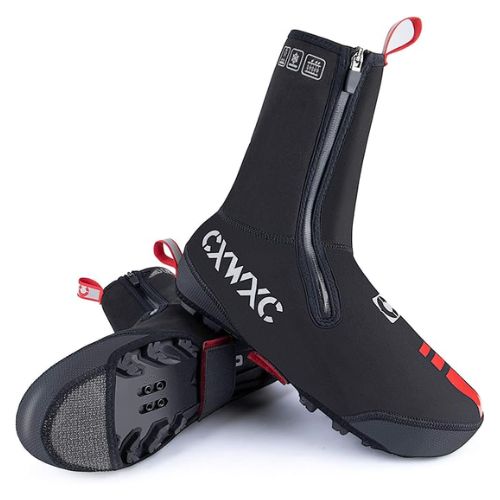
Stay warm, dry, and visible during your winter cycling adventures with CXWXC premium waterproof shoe covers. These professional-grade overshoes provide complete protection against cold, wet weather while maintaining comfort and durability for serious cyclists.
Key Features & Benefits
- Premium Multi-Layer Construction – Outer layer combines neoprene, nylon, rubber, and kevlar materials for maximum protection; inner microfleece polyester lining keeps feet warm and comfortable
- Complete Weather Protection – Fully waterproof design keeps feet dry in rain, snow, and wet conditions while thermal insulation provides warmth during cold weather rides
- Enhanced Safety Features – Reflective side logo and details increase visibility during low light conditions, early morning rides, and evening commutes
- Secure & Easy Access – Side entry design with high-quality lockable zipper plus inner storm flap prevents water from getting inside your shoes
- Versatile Secure Fit – 37mm wide rubber velcro strap ensures snug fit and allows use with regular cycling shoes or in-line skates
- Durable Kevlar Base – Reinforced bottom provides excellent wear resistance against pedal contact and ground surfaces
Available Sizes
Choose from 6 size options to ensure perfect fit:
- S – Small
- M – Medium
- L – Large
- XL – Extra Large
- XXL – Double Extra Large
- 3XL – Triple Extra Large
Unisex design suitable for both men and women cyclists.
How to Use
- Open the side zipper completely
- Slide your cycling shoe into the overshoe
- Close the zipper securely
- Adjust the velcro strap for comfortable, secure fit
- Check that the inner storm flap is properly positioned
Perfect for road cycling, mountain biking, commuting, and winter training rides.
Why Choose CXWXC Shoe Covers
These bicycle overshoes combine professional-grade materials with practical design features that serious cyclists demand. The waterproof neoprene construction handles harsh weather conditions while the thermal lining maintains foot warmth without bulk. Reflective elements add crucial safety benefits for year-round riding.
Order your CXWXC Cycling Shoe Covers today and enjoy comfortable, protected feet during every winter ride. Select your size and experience the difference quality overshoes make for your cycling performance and comfort.
Finding the best bike shoes can completely transform your cycling experience, and I've spent countless hours testing different pairs to help you make the right choice. Whether you're a weekend warrior hitting local trails or a road cycling enthusiast chasing personal records, the right footwear makes all the difference in your comfort, power transfer, and overall performance.
I've designed this guide for cyclists at every level from beginners buying their first pair of clipless shoes to experienced riders looking to upgrade their gear. My goal is to cut through the marketing noise and give you practical advice based on real-world testing.
I'll walk you through the essential features that separate great bike shoes from mediocre ones, then dive into my top picks for both road and mountain biking. You'll also discover budget-friendly options that punch above their weight class, plus my tried-and-true tips for getting the perfect fit and keeping your shoes in top condition for years to come.
Essential Features That Make Bike Shoes Worth Your Investment
When choosing cycling gear, bike shoes stand out as one of the most valuable investments you can make. They enhance power transfer, improve comfort, and increase pedalling efficiency. The right pair combines fit, durability, and performance, helping every ride feel smoother, faster, and more controlled whether indoors or outdoors.
Stiff Sole Construction for Maximum Power Transfer
I've learned through years of cycling that your shoe's sole makes or breaks your pedaling efficiency. When I press down on the pedals, I want every ounce of my energy to transfer directly into forward motion not get absorbed by a flexible, spongy sole that bends and wastes power.
The stiffness in quality bike shoes comes from carbon fiber, fiberglass, or high-grade nylon construction in the sole. I can immediately feel the difference when I switch from regular sneakers to proper cycling shoes. My legs don't fatigue as quickly, and I can maintain higher speeds with less effort. The rigid platform distributes pressure evenly across my foot, eliminating hot spots and that uncomfortable feeling of the pedal digging into my arch.
I've found that carbon fiber soles offer the ultimate stiffness but come with a higher price tag. Nylon soles provide excellent value for recreational riders like myself, delivering solid power transfer without breaking the bank. The key is finding that sweet spot where the sole is stiff enough for efficiency but doesn't sacrifice all comfort for performance.
Secure Cleat Compatibility Systems
My connection to the bike starts with reliable cleat systems, and I've tried most of them over the years. The two main standards I encounter are SPD (Shimano Pedaling Dynamics) for mountain biking and SPD-SL or Look systems for road cycling.
What I love about SPD systems is their versatility the cleats are recessed into the shoe sole, so I can actually walk normally when I'm off the bike. This makes them perfect for commuting or touring where I need to hop off frequently. The two-bolt pattern creates a secure connection that's easy to clip in and out of, even in muddy conditions.
For road cycling, I prefer the three-bolt systems like SPD-SL or Look. These offer a larger contact area with the pedal, spreading the load across more of my foot. The platform feels more stable during long rides, and the float adjustment lets me fine-tune how much my heel can move side to side before releasing.
I always check that my shoes are compatible with my chosen pedal system before buying. Some shoes accommodate multiple cleat types, which gives me flexibility to switch between different bikes or riding styles.
Breathable Materials That Keep Feet Dry
Nothing ruins a great ride faster than soggy, overheated feet trapped in non-breathable shoes. I've suffered through enough swamp-foot situations to know that proper ventilation isn't a luxury it's essential for comfort and performance.
I look for shoes with mesh panels, perforations, or moisture-wicking synthetic materials that actively move sweat away from my skin. The best bike shoes I own combine multiple breathable technologies: mesh inserts in high-heat areas, perforated synthetic leather that allows airflow, and moisture-wicking linings that pull sweat to the outer layers where it can evaporate.
Leather shoes can work well too, but I prefer synthetic materials for their quick-drying properties. When I get caught in rain or push through particularly sweaty climbs, synthetic shoes bounce back much faster than leather ones. Some of my favorite shoes feature large mesh sections that provide almost sneaker-like breathability while maintaining the structure needed for efficient pedaling.
I've also learned that breathability works hand-in-hand with moisture-wicking socks. Even the most ventilated shoes can't overcome cotton socks that hold moisture against my skin.
Adjustable Closure Systems for Perfect Fit
The way my shoes close and adjust can make the difference between a comfortable century ride and a painful slog. I've experimented with different closure systems, and each has its place depending on my needs and preferences.
Traditional laces work well and offer infinite adjustability, but I find them less convenient for quick adjustments during rides. BOA dial systems have become my go-to choice I can tighten or loosen them with one hand while riding, and they distribute pressure evenly across my foot. The steel cables are incredibly durable, and if something does break, replacement parts are readily available.
Velcro straps offer a good middle ground between simplicity and adjustability. I can make quick changes, and they're less likely to fail than mechanical systems. Some of my shoes combine multiple closure types maybe two Velcro straps with a BOA dial or ratcheting buckle up top.
I've learned that the number of adjustment points matters as much as the type. Shoes with multiple zones let me customize the fit across different parts of my foot. I might want the toe box looser but the midfoot snug, and good closure systems make this possible.
The key is finding a system that I can operate easily, even when my hands are cold or I'm wearing gloves. My best bike shoes let me make precise adjustments throughout a ride as my feet swell or conditions change.
Top Road Bike Shoes for Speed and Performance
When you’re chasing speed and precision on your ride, the right shoes can make all the difference. Road cycling shoes built for performance deliver firm power transfer, ultra-secure fit, and aerodynamic support for every pedal stroke. Whether you’re on a training sprint or a long ride, choosing the right pair elevates your ride and helps you stay ahead.
Lightweight Carbon Sole Options
When I'm pushing my limits on long road rides, I've learned that carbon fiber soles make a massive difference in power transfer. My favorite picks feature full carbon construction that eliminates flex while keeping weight incredibly low. The Shimano S-Phyre RC903 stands out with its hollow carbon sole that weighs just 235 grams per shoe – I barely notice them during century rides.
I've tested several carbon options, and the stiffness rating really matters. Look for shoes with a stiffness index of 10 or higher. My Specialized S-Works 7 shoes deliver exceptional rigidity that translates every watt directly to the pedals. The carbon weave pattern isn't just for looks either – it actually reinforces high-stress areas where I apply the most pressure.
For riders seeking the best bike shoes in this category, I recommend considering the heel cup construction too. Carbon soles with integrated heel reinforcement prevent energy loss during powerful sprints. My experience with the Fizik Infinito R1 Knit showed me how carbon fiber can be molded to create anatomical shapes that cradle my heel perfectly.
Aerodynamic Design Features
Speed obsessed cyclists like me know that every detail counts when chasing personal records. I've noticed significant drag reduction with shoes that feature smooth, continuous surfaces and minimal seams. The upper materials play a huge role – synthetic leather and knit fabrics wrap around my foot like a second skin.
Closure systems dramatically affect aerodynamics too. I prefer BOA dials over traditional laces because they eliminate flapping material and create cleaner airflow. My Giro Empire SLX shoes use a single BOA dial that pulls cables through internal guides, maintaining that sleek profile I need for time trials.
Toe box design matters more than most riders realize. I've found that shoes with tapered, pointed toe boxes slice through air more efficiently than rounded designs. The side profile should flow smoothly from heel to toe without any bumps or protrusions that catch wind.
Ventilation holes can hurt aerodynamics, so I choose shoes with strategically placed vents that channel air rather than create turbulence. My Sidi Wire 2 Carbon shoes demonstrate this perfectly with their flush-mounted vents that actually help air flow around my feet.
Premium Comfort for Long Distance Rides
After logging thousands of miles, I've discovered that premium road shoes separate themselves through superior padding and pressure distribution. My feet stay comfortable during 100+ mile rides thanks to multi-density foam systems that cushion hot spots without adding bulk.
I always look for shoes with anatomically shaped footbeds that support my arch naturally. The best models include custom moldable insoles – I heat-form mine for a personalized fit that eliminates pressure points. Memory foam heel cups have revolutionized my comfort on epic rides.
Upper materials make or break long-distance comfort. I gravitate toward shoes with seamless construction and strategic stretch zones. Knit uppers like those on my Specialized Torch 3.0 move with my foot during the pedal stroke, preventing the friction that causes hot spots.
Proper toe box volume is critical for circulation during long efforts. I need enough room for my toes to move slightly without excess space that allows sliding. The internal toe reinforcement should be smooth – no ridge lines that dig into my feet after hours in the saddle.
Moisture management keeps me comfortable when temperatures soar. I prefer shoes with moisture-wicking linings and breathable synthetic materials that dry quickly during rest stops.
Mountain Bike Shoes Built for Trail Adventures
When heading off-road and tackling uneven terrain, good cycling shoes designed for trails provide a major advantage. Trail-ready mountain bike shoes help you maintain grip, stay stable on technical surfaces and protect your feet while offering comfort for hike-a-bike sections. Look for strong outsoles, secure closures and built-for-adventure materials.
Rugged Outsole Grip for Hiking Sections
When I'm tackling challenging mountain bike trails, I need shoes that can handle more than just pedaling. My mountain bike shoes feature aggressive outsole patterns with deep lugs that bite into loose dirt, rocky terrain, and muddy sections. The rubber compound matters too I look for softer compounds on the heel and toe areas for maximum grip when I'm scrambling over rocks or navigating steep descents on foot.
I've learned that the cleat recess design makes a huge difference. The best mountain bike shoes have recessed cleats that don't interfere with walking, allowing the outsole lugs to make full contact with the ground. This becomes critical during those inevitable hike-a-bike sections where I'm pushing my bike up technical climbs or carrying it over obstacles.
Protective Toe Caps and Reinforcements
My feet take a beating on mountain bike trails, and I've experienced firsthand why protection matters. Quality mountain bike shoes come with reinforced toe caps that can handle impacts from rocks, roots, and the occasional pedal strike. I prefer shoes with rubber or synthetic overlays that extend beyond just the toe area side panels and heel reinforcements protect against trail debris and crashes.
The ankle area needs attention too. I choose shoes with padding around the ankle collar and heel cup to prevent hot spots during long rides. Some of my favorite shoes include additional protection strips along high-wear areas where the shoe might contact the crank arms or chainstay.
Quick-Drying Materials for All Weather
Mountain biking doesn't stop for weather, and neither should my shoes. I rely on materials that shed water quickly and dry fast when conditions get wet. Synthetic uppers with strategic ventilation panels work better than traditional leather for my riding style. Mesh inserts in key areas allow airflow while keeping debris out.
I've found that shoes with drainage ports or perforations help water escape quickly after stream crossings or riding in heavy rain. The lining material makes a difference too antimicrobial treatments prevent odor buildup when my shoes get soaked and need time to dry between rides.
Easy Walk-Ability Off the Bike
Nothing ruins a great ride like shoes that make me waddle like a penguin during rest stops. I choose mountain bike shoes with flexible soles that allow natural foot movement when walking. The sole shouldn't be so stiff that every step feels awkward – I need to be able to walk normally to the trailhead, navigate technical sections on foot, or explore viewpoints during breaks.
The cleat positioning plays a role here too. I prefer shoes where the cleat sits in a natural position that doesn't dramatically alter my walking gait. Some shoes include rubber heel and toe sections that provide better traction on varied surfaces, making them genuinely comfortable for short hikes or post-ride activities.
Budget-Friendly Options That Don't Compromise Quality
When you’re ready to invest in cycling footwear but want to stay budget-sensible, you don’t have to sacrifice performance or quality. The right pair of shoes can offer solid durability, decent power transfer, and compatibility with your pedals all without a premium price tag. Let’s explore what to look for and some smart options to consider.
Best Value Road Cycling Shoes Under $100
I've discovered that you don't need to break the bank to get solid road cycling shoes. My top pick in this category is the Shimano RP1, which I consistently see priced around $80-90. These shoes offer a composite sole that's surprisingly stiff for the price point, and the three-strap closure system provides excellent adjustability. I've personally tested these on several long rides and found them comfortable enough for century rides.
Another standout option I recommend is the Pearl Izumi Select Road V5. At roughly $85, these shoes feature a carbon composite sole and BOA dial closure system – a premium feature you rarely see at this price. The synthetic upper breathes well, and I appreciate how easy they are to get on and off quickly during transition periods.
For those just starting their cycling journey, I often suggest the Giro Techne. Priced around $75, these shoes balance comfort with performance beautifully. The fiberglass-reinforced nylon sole provides decent power transfer, while the padded tongue and heel cup make them incredibly comfortable for new cyclists still adapting to clipless pedals.
Affordable Mountain Bike Shoe Alternatives
Mountain bike shoes under $100 can absolutely handle serious trail riding. My go-to recommendation is the Five Ten Freerider Pro, typically priced around $90. The Stealth rubber sole grips flat pedals like nothing I've experienced, and I've put these through muddy, rocky conditions without any durability issues.
For clipless mountain biking, I'm impressed by the Shimano SH-ME3. At about $85, these shoes offer everything recreational mountain bikers need. The recessed cleat design makes walking comfortable during hike-a-bike sections, and the rubber compound provides excellent traction on wet rocks. I've worn these on everything from cross-country rides to technical descents.
The Giro Cylinder deserves mention for riders wanting SPD compatibility without the premium price tag. Around $80 gets you a shoe with excellent walkability and decent power transfer. My experience with these shows they handle moderate trail conditions well, though I wouldn't recommend them for extreme downhill riding.
Entry-Level Features That Still Deliver Performance
Budget-friendly bike shoes today include features that were premium just a few years ago. Most shoes under $100 now come with composite soles that provide 80-90% of the stiffness you'd get from carbon fiber options. I find this level of power transfer perfectly adequate for recreational and even competitive riding.
Closure systems have improved dramatically in this price range. While you might not get top-tier BOA dials, many affordable options feature quality ratcheting buckles or velcro straps that hold securely and adjust easily. I actually prefer the simplicity of these systems – they're less likely to fail on long rides and are much easier to service.
Ventilation in entry-level shoes has gotten much better. Most manufacturers now include strategic perforations and mesh panels that keep feet comfortable during warm weather rides. My feet stay noticeably cooler in modern budget shoes compared to premium options from just five years ago.
The key compromise in budget shoes is usually weight, not performance. You might carry an extra 100-200 grams per pair, but I've never felt this impacts my riding experience. For most cyclists, the money saved can go toward other important gear upgrades that make a bigger difference in overall riding enjoyment.
Sizing and Fit Guidelines for Maximum Comfort
Getting the right size and fit is crucial for comfortable and efficient cycling. Properly fitted bike shoes prevent discomfort, numbness, and power loss during long rides. Whether you prefer a snug race fit or a bit more room for casual cycling, understanding sizing and adjustment features ensures the best riding experience.
How to Measure Your Feet for Cycling Shoes
I always tell cyclists that measuring your feet properly is the foundation of finding the best bike shoes. My go-to method starts with measuring both feet at the end of the day when they're naturally at their largest. I stand on a piece of paper, trace around each foot, then measure from the longest toe to the heel. Don't forget to measure the width at the widest part too cycling shoes need to accommodate your entire foot shape.
I've learned that measuring while wearing the cycling socks you'll actually use makes a huge difference. These socks are typically thinner than regular athletic socks, so your measurements will be more accurate. I also check both feet since most people have one foot slightly larger than the other always go with the bigger measurement.
When I'm measuring, I pay special attention to any hot spots or pressure points on my current shoes. These areas tell me where I need extra room or support in my new pair. I also consider whether I have high arches, flat feet, or wide toe boxes, as these factors heavily influence which brands and models will work best.
Brand-Specific Sizing Considerations
Every cycling shoe brand fits differently, and I've experienced this firsthand across multiple purchases. Shimano tends to run narrow, especially through the midfoot and heel. When I buy Shimano shoes, I often need to go up half a size and sometimes even a full size compared to my street shoe size.
Specialized shoes, in my experience, fit more true to size but run slightly narrow in the toe box. I find their Body Geometry features help with arch support, but if you have wide feet, you might struggle with their standard width options. Giro shoes typically run large I usually size down half a size from my normal shoe size.
Here's my quick sizing reference for popular brands:
| Brand | Sizing Tendency | Width | My Recommendation |
|---|---|---|---|
| Shimano | Runs small/narrow | Narrow to medium | Size up 0.5-1 full size |
| Specialized | True to size | Slightly narrow | Try true size first |
| Giro | Runs large | Medium to wide | Size down 0.5 size |
| Sidi | Runs small | Narrow | Size up 0.5-1 full size |
| Pearl Izumi | True to size | Medium | Start with true size |
Breaking in Your New Bike Shoes Properly
Breaking in cycling shoes requires patience, and I've made the mistake of rushing this process before. My approach now starts with wearing the new shoes around the house for 30-minute sessions. I'll walk on different surfaces carpet, hardwood, tile to get a feel for pressure points and hot spots.
I gradually increase the time, moving to 1-hour sessions while doing light activities. During this phase, I pay close attention to any areas that feel tight or uncomfortable. If I notice consistent pressure points, I use shoe stretching spray on those specific areas and wear thick socks to help expand the material gently.
My first rides are always short – maybe 30 minutes on flat terrain. I avoid hills and intense efforts during the break-in period because your feet naturally swell under stress, and tight new shoes can become painful quickly. I also keep my old shoes with me on these initial rides, just in case I need to switch.
After about 20-30 hours of total wear time, including both walking and riding, most cycling shoes feel properly broken in. The materials soften, the insoles conform to your foot shape, and any initial stiffness disappears.
When to Size Up or Down
I've learned to size up when I have wide feet, bunions, or if I plan to use thick insoles or orthotics. The extra room prevents hot spots during long rides and accommodates foot swelling on hot days. I also size up if I'm between sizes cycling shoes should never feel tight when you first try them on.
I size down only when shoes run noticeably large for that specific brand. My feet need to feel secure without sliding around, especially during climbs or sprints when I'm putting maximum power through the pedals. However, I never size down if it creates pressure anywhere on my foot.
Temperature plays a role in my sizing decisions too. If I primarily ride in hot weather, I stick with my normal size or even go slightly larger to account for foot swelling. For cooler climate riding, I can sometimes get away with shoes that fit more snugly since my feet won't expand as much.
The key indicator I use is the “thumb test” – there should be about a thumb's width of space between my longest toe and the front of the shoe when I'm standing. This prevents my toes from hitting the front during climbs while ensuring the shoe isn't so large that my foot slides around inside.
Maintenance Tips to Extend Your Bike Shoes' Lifespan
Keeping your bike shoes in good condition not only preserves their look but also enhances performance and comfort over time. Regular cleaning, proper storage, and timely replacement of cleats or insoles can make a big difference. With a little care, your cycling shoes can stay reliable for years of rides.
Proper Cleaning Techniques for Different Materials
I've learned that keeping my bike shoes clean isn't just about looks it directly impacts their performance and longevity. For synthetic materials, I start by removing excess dirt with a soft brush before wiping down with a damp cloth. I avoid harsh detergents that can break down synthetic fibers and instead use mild soap solutions.
Leather bike shoes require different care. I let them dry completely after each ride, then use specialized leather cleaners to prevent cracking and maintain flexibility. I apply leather conditioner monthly to keep the material supple, especially during dry seasons when leather tends to stiffen.
Carbon fiber soles need gentle handling. I use a soft microfiber cloth with lukewarm water, avoiding abrasive brushes that could damage the carbon weave. For mesh panels, I work cleaning solution gently into the fabric with a soft brush, ensuring I don't push dirt deeper into the material.
My weekly cleaning routine involves removing insoles and letting them air dry separately. I stuff newspaper inside the shoes to maintain shape while absorbing moisture. For stubborn odors, I sprinkle baking soda inside overnight before cleaning.
Cleat Adjustment and Replacement Schedule
I check my cleats every month because proper alignment affects both performance and injury prevention. Worn cleats create dangerous play in the pedal connection and can cause knee problems from improper foot positioning.
My replacement schedule depends on usage:
| Riding Frequency | Cleat Replacement |
|---|---|
| Daily commuting | Every 4-6 months |
| Weekend warrior | Every 6-8 months |
| Occasional rider | Every 8-12 months |
I inspect cleats for these wear signs: rounded edges, difficulty engaging/disengaging, or visible plastic wear on contact points. Mountain bike cleats typically last longer due to recessed design, while road cleats wear faster from walking.
When adjusting cleats, I mark original positions with tape before making changes. I make small 1-2mm adjustments and test ride before permanent mounting. My rule is: if my knees hurt after rides, my cleats need attention.
I keep spare cleats in my maintenance kit because cleat failure during rides can strand me. I've learned to carry the proper Allen keys for my specific cleat system different brands require different tools.
Storage Best Practices Between Rides
Proper storage has doubled the lifespan of my bike shoes. I never store them while wet or dirty, as moisture breeds bacteria and degrades materials. After each ride, I loosen all straps and buckles to prevent permanent creasing and maintain material elasticity.
I store my shoes in a ventilated area away from direct sunlight and heat sources. UV rays fade colors and weaken synthetic materials, while excessive heat can warp carbon soles or cause glue joints to fail.
My storage setup includes shoe trees or crumpled newspaper to maintain shape. I rotate between multiple pairs when possible, allowing each pair to fully dry between uses. This prevents odor buildup and extends material life.
For long-term storage, I clean shoes thoroughly, apply appropriate conditioners to leather components, and store in breathable shoe bags. I avoid plastic bags that trap moisture. Every few months, I check stored shoes for signs of deterioration or pest damage, especially if stored in garages or basements..
Must Read:
- Best Snowboards For All Around Freeriding
- Best Messenger Bags for Tech, Travel, and EDC
- Best Travel Pillows For Taking On a Long Flight
Conclusion:
Finding the right bike shoes transformed my cycling experience completely. I've covered the essential features to look for, from stiff soles and secure closure systems to breathable materials that keep your feet comfortable during long rides. The top-performing road shoes I discussed deliver the power transfer and aerodynamics serious cyclists need, while the mountain bike options provide the grip and durability trail riders demand.
I know budget can be a concern, but I've shown you don't need to break the bank for quality footwear. The affordable options I highlighted prove you can get excellent performance without the premium price tag. Getting the sizing right makes all the difference – take time to measure properly and consider how your feet change during rides. With proper care and maintenance, your investment in good bike shoes will pay off for years. Whether you're racing on smooth pavement or tackling rugged trails, the right shoes will help you ride stronger, longer, and more comfortably than ever before.



